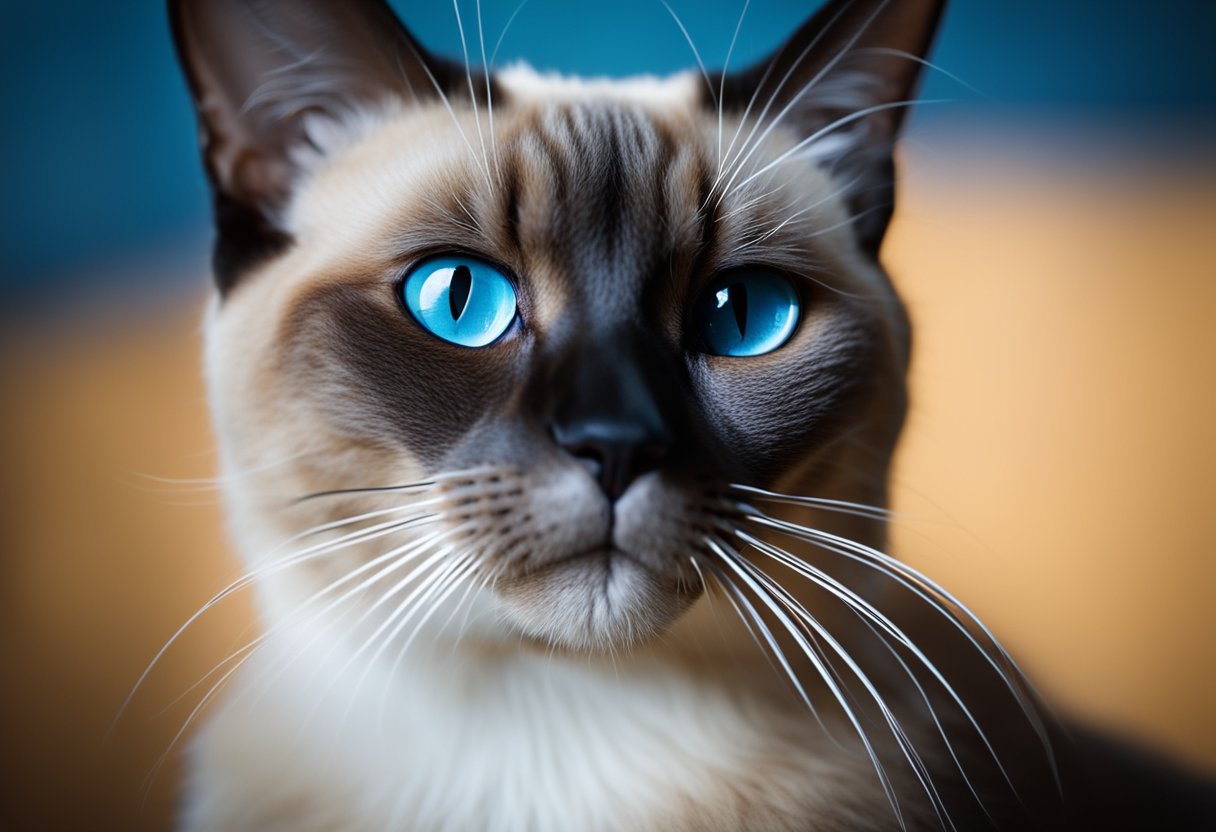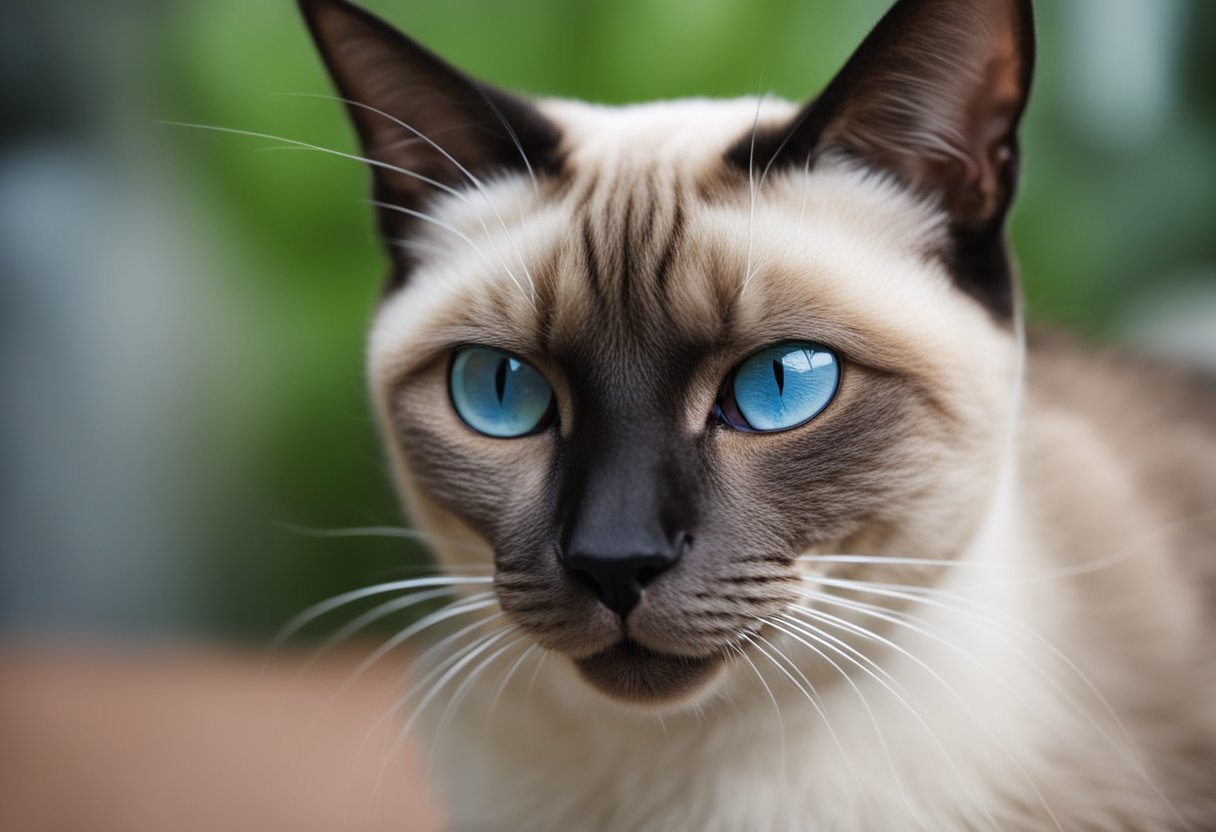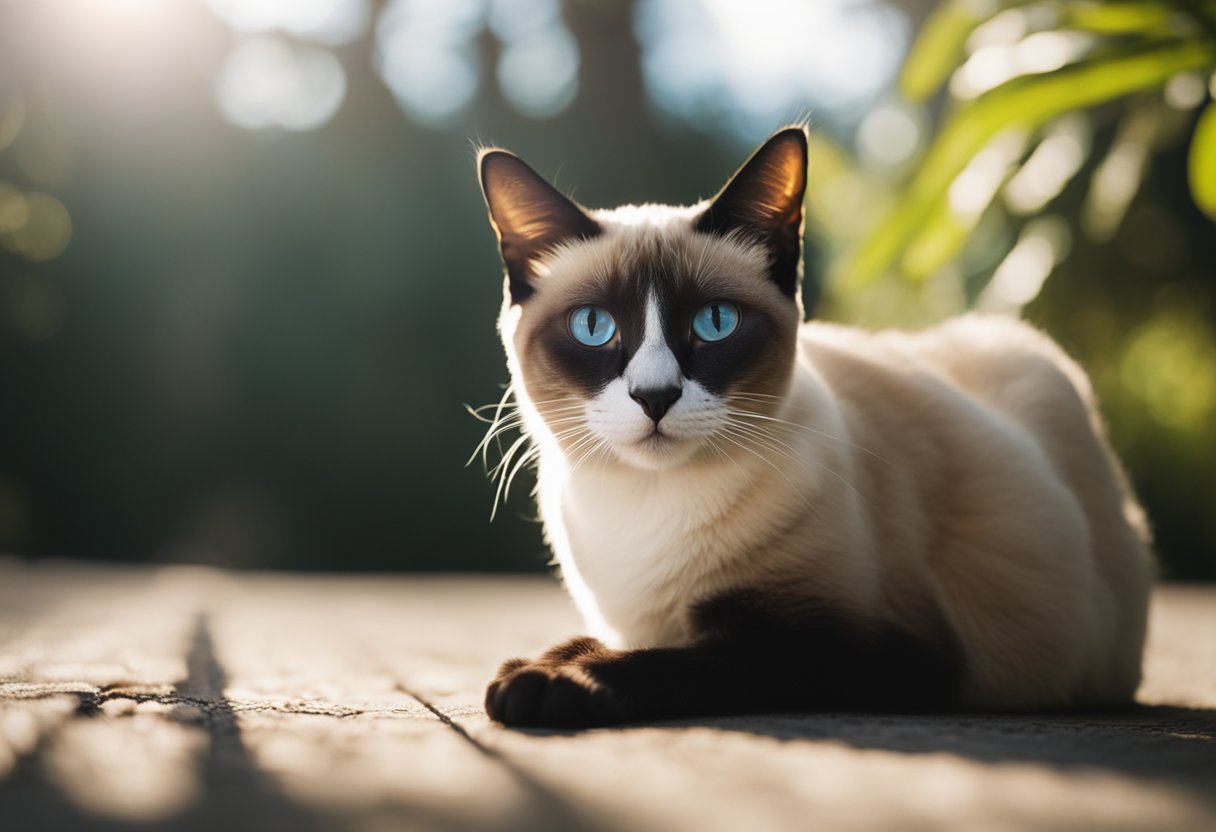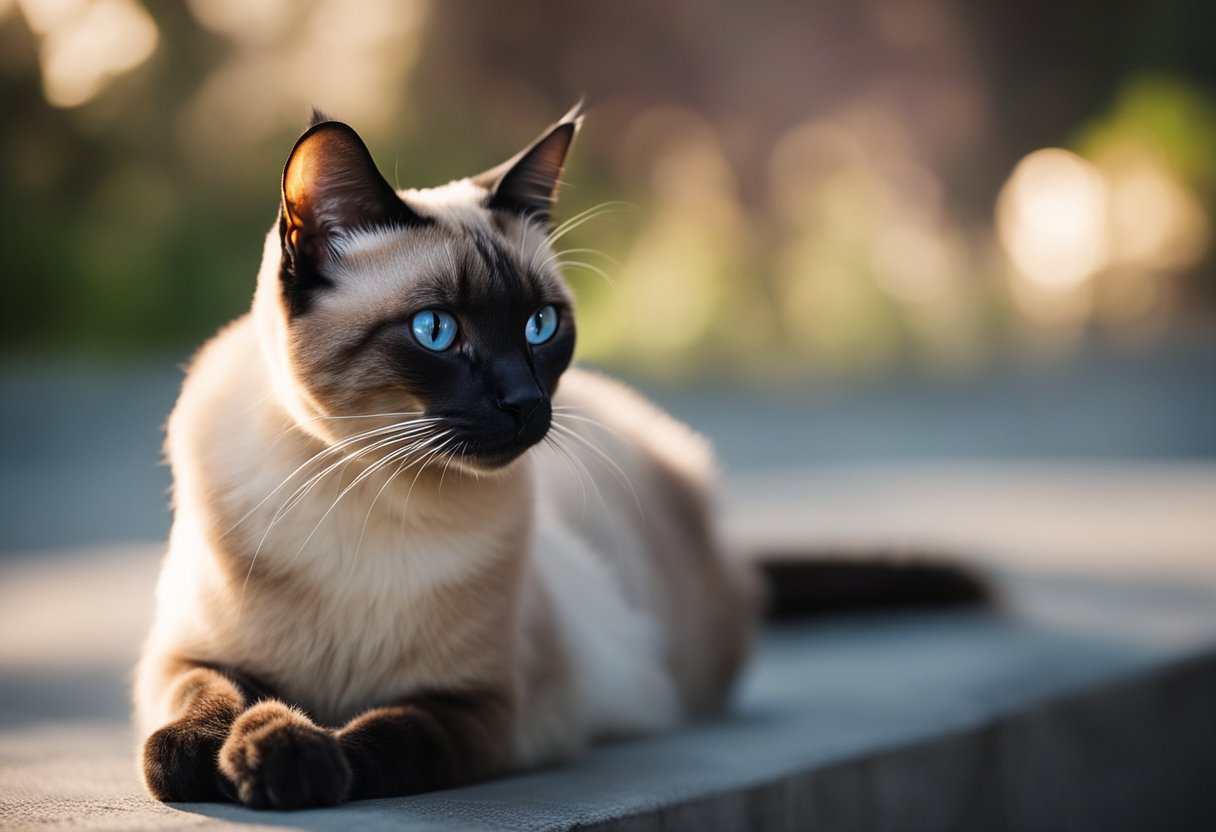Siamese cats are renowned for their striking and unique coat pattern, characterized by darker fur on their ears, face, paws, and tail, with a lighter body color. This distinctive feature is a result of temperature-sensitive enzymes that affect the cat’s fur pigment. The enzymes cause the fur to be darker in the cooler parts of the body and lighter where the body is warmer. A genetic mutation known as the Himalayan gene is responsible for this unique coloration, influencing the pigmentation according to the varying temperatures across their bodies.

Various factors can cause shifts in the color of a Siamese cat’s coat over time. Changes in the body temperature due to environmental factors, age, or even seasonal shifts can lead to noticeable differences in their fur color. Kittens, for example, are born white because they have been in the warmth of their mother’s womb. As they grow and their body temperature changes, so does the color of their fur. Additionally, the color intensity might fluctuate with the seasons or in response to physical health and well-being, adding another layer of dynamism to their appearance.
Key Takeaways
- Siamese cats have a unique coat due to temperature-sensitive enzymes affected by the Himalayan gene.
- Environmental and bodily factors, including temperature fluctuations, alter their fur color.
- A Siamese cat’s age, health, and seasonal changes can influence their coat color intensity.
Genetics of Siamese Cats

The remarkable color-changing coat of Siamese cats is due to a precise genetic mechanism that involves temperature-sensitive albinism controlled by the Himalayan gene, which affects melanin production through tyrosine metabolism.
The Himalayan Gene
The Himalayan gene is a particular form of genetic mutation that leads to temperature-sensitive albinism in Siamese cats. This gene acts as a form of a switch that inhibits pigment production in the fur at certain temperatures. It is only when the body temperature drops below a specific threshold, typically around or below 98 degrees Fahrenheit, that the gene allows for melanin, the pigment that colors the fur, to be produced.
Tyrosine Metabolism and Pigment Production
Tyrosine metabolism is crucial for melanin synthesis. In Siamese cats with the Himalayan gene, this enzyme-driven process is modified to be temperature dependent. At cooler body temperatures, tyrosine metabolism is normal, resulting in the characteristic dark points on the ears, face, paws, and tail where the temperature is cooler. On the warmer parts of the body, this metabolic pathway is less active, leading to lighter fur colors. This unique genetic trait exemplifies the intricate relationship between a cat’s genetics and its external appearance.
Color Point Characteristics

The color points in Siamese cats are distinct, darker patches of fur that contrast with the lighter body color. These points appear on the extremities of the cat, including the face, ears, paws, and tail, and are a hallmark of the breed.
Defining Color Points
Color points refer to the sections of a Siamese cat’s fur that are a different and darker shade than the rest of its body. The points result from a temperature-sensitive gene that causes the fur to darken on cooler parts of the body, such as the nose, paw pads, and ears. This distinct fur pigmentation is seen in the breed from birth, although the contrast intensifies as they mature and are exposed to varying temperatures.
Common Point Colors of Siamese Cats
Siamese cats are known for four primary point colors:
- Seal Point: The darkest of the four, with nearly black points.
- Chocolate Point: A lighter brown tone on the points, with a creamy body color.
- Blue Point: Grayish points with a bluish tinge, accompanied by a bluish-white body.
- Lilac Point: The lightest, with pinkish-gray points and a glacial white body.
These point colors are a defining feature of the Siamese breed and influence the distinctive look that these cats are celebrated for. The points become more pronounced in colder temperatures, and over time, the coat color may deepen in shade.
Factors Influencing Color Change

Siamese cats exhibit a distinctive ability to change coat color influenced by a variety of factors, most notably temperature but also including aging, diet, and health. This section will explore how these dynamics contribute to the color change phenomenon in Siamese cats.
Temperature and Color Change
Temperature plays a crucial role in the color of a Siamese cat’s fur. The fur contains temperature-sensitive enzymes that react differently depending on the warmth of the environment. In cooler conditions, these enzymes facilitate a darker hue in the cat’s extremities, while warmer temperatures maintain a lighter coloration.
Aging and Coloration
As Siamese cats grow older, their enzymatic coat color change is affected by the aging process. The coat often becomes darker with age, which is a natural result of the gradual changes in body temperature regulation and enzyme activity in their fur.
Diet and Coat Color
A Siamese cat’s diet contributes to their fur’s color as well. Dietary imbalances, specifically in nutrients such as tyrosine, an amino acid that’s crucial for melanin production, can cause noticeable changes to the coat. Intake of adequate nutrition can help maintain the enzyme’s optimal functionality, which affects coat color.
Health Conditions Impacting Color
Certain health conditions can alter a Siamese cat’s fur color. For example, a tyrosine deficiency not only impacts metabolism but can lead to a lighter coat. Moreover, other medical conditions affecting the cat’s overall health can indirectly influence fur coloration through changes in body temperature or enzyme activity.
The Siamese Cat Lifecycle

Siamese cats exhibit a fascinating lifecycle, with their fur colors changing significantly from the time they are kittens to being fully grown cats. These changes are influenced by a mix of age-related development and temperature variations.
From Kitten to Adult
Siamese kittens are born with a creamy white fur which gradually develops color markings as they mature. The significant changes begin to manifest due to an enzyme related to body temperature. Specifically, the enzyme, tyrosinase, becomes less active at higher body temperatures, resulting in lighter fur. In contrast, cooler areas of the skin, such as the ears, nose, paws, and tail, stay darker. As the Siamese cat ages, their body temperature and skin temperature stabilize, which then establishes a more consistent coat color.
Seasonal and Aging Changes
The lifecycle of a Siamese cat encompasses seasonal fur changes. During winter, the cooler climate may lead to a darker coat, sometimes described as a winter coat or winter undercoat, due to the drop in skin temperature. Conversely, the coat may lighten again as temperatures rise. Not only this, but as Siamese cats continue aging, it’s observed that their coat can gradually darken overall, irrespective of the season. This gradual darkening is a combined result of the progressive decrease in body temperature with age and possibly age-related changes in enzyme activity.
Caring for a Siamese Cat
When it comes to caring for a Siamese cat, understanding their unique needs is essential. This includes regular check-ups and being cognizant of how temperature can affect their coat color.
Veterinarian Visits
Regular visits to the veterinarian are vital for maintaining the health of a Siamese cat. Siamese cats may be prone to certain health conditions that can affect their color change and overall health. Siamese cat owners should:
- Schedule annual check-ups.
- Keep up with vaccinations and preventative care.
- Monitor for any signs of health changes, especially those affecting coat color as it may indicate a temperature shift or health issue.
Understanding Temperature Effects
Siamese cats’ coats are temperature-sensitive, due to a genetic trait that causes their color to change in response to their body’s warmth. Owners should be aware of:
- The warmer the body part, the lighter the fur color.
- Cooler areas of the body will have darker fur.
- Environmental temperatures can also lead to a visible color shift.
Keeping your Siamese cat’s environment at a consistent temperature can help manage color changes and ensure they are comfortable.
Breeding and Coat Color Variation
The variation in Siamese cats’ coat colors is a direct result of specific breeding practices and their unique genetic makeup. These breeding efforts highlight the intriguing way in which color points and overall appearance are influenced.
Selective Breeding for Color Points
Selective breeding in Siamese cats has been carried out to enhance certain desirable features, specifically their color points – the contrasting coloration on their ears, face, paws, and tail. By choosing cats with distinct color points, breeders can influence the patterns and intensities of these areas in the offspring. For instance, breeding a Siamese cat with prominent seal points, which are deep brown or black, may increase the likelihood of these features in the next generation.
Genetic Diversity and Appearance
The genetic diversity in Siamese cats affects more than just their color points; it also plays a role in other aspects of their appearance, like blue eyes and body shape. A clear example of genetic influence is the presence of gray hairs or a change in the undercoat color due to temperature shifts, an aspect inherent to the breed. While a vegetarian diet or changes in environment don’t affect their coat color, the genetic makeup is sensitive to temperature, which causes the coat changes that Siamese cats are known for. This is not to be confused with other breeds such as the Ragdoll, which may have similar points but owe their patterns to different genetic conditions.
Unique Attributes of Siamese Cats
Siamese cats are distinguished within the feline world by their striking color patterns and captivating blue eyes. One of the most fascinating characteristics of Siamese cats is their color-changing coat. This phenomenon is due to their temperature-sensitive pigments. Kittens are usually born white and develop their darker points—areas on their face, ears, paws, and tail—as they mature and are exposed to cooler temperatures.
Temperature and Pigmentation:
- Warmer skin: Lighter fur
- Cooler skin: Darker fur
The gene responsible for this color change is a form of partial albinism, where cooler parts of the body have darker fur. This is why Siamese cats may exhibit a lighter body with contrasting darker extremities. The temperature-dependent enzyme responsible for this pigment distribution is less active in warm body areas, hence the lighter color.
Siamese Cat Colors:
- Seal Point
- Chocolate Point
- Blue Point
- Lilac Point
Each of these colors reflects the specific darker points a Siamese cat can have, and these colors can vary in intensity and shades throughout their lives. The colder the area of the body, the darker the fur which can be affected by factors such as climate and even the cat’s health.
Recognized as one of the oldest and most revered cat breeds, Siamese cats carry a rich history alongside their unique genetic makeup. They are not just visually stunning but also known for their social and vocal nature, often forming a strong bond with their human companions. Their compelling attributes extend beyond their appearance, making the Siamese an enduring favorite among cat enthusiasts.
Myths and Misconceptions
Many people mistakenly believe that Siamese cats are albinos. This is not true. Although they may have a light coat that can be associated with albinism, the color changes in Siamese cats stem from a genetic mutation known as the Himalayan gene, which affects pigmentation based on body temperature, and not from albinism.
Some believe that all Siamese cats start as black cats and then change color. This is a misunderstanding. While Siamese kittens are born white or cream, they develop their points—areas of darker color on the ears, face, paws, and tail—as they mature, influenced by their body temperature, but they are never fully black.
Others assume Siamese cats’ coat color change might be indicative of poor health, but this is often a misconception. The transformation of a Siamese cat’s fur color is a natural characteristic of the breed and not typically associated with health issues.
Also, a prevalent myth is that the Siamese cat’s fur can change color on demand or due to mood. This is not accurate. Their coat color is mostly influenced by external factors, such as ambient temperature and seasonal changes, rather than their emotional state. For example, in warmer climates or seasons, their coat tends to lighten, whereas colder conditions darken their fur, especially in areas of cooler body temperature.
It is important to challenge these myths with factual information to better understand the unique traits of Siamese cats and appreciate the genetic marvel that dictates their coat coloration.
Future Research and Developments
Future research into Siamese cats’ color-changing fur may focus on genetic mapping to understand better the specific genes responsible for this unique feature. Scientists are already aware that a gene associated with temperature-sensitive fur coloration, known as the Himalayan gene, plays a critical role. By elucidating the precise mechanisms at play, researchers could enhance breeding strategies and even contribute to the fields of genetics and heredity at large.
Further studies may examine how environmental factors and genetic makeup interact to influence color change, leading to a comprehensive insight into the phenotypic expression in these cats. This could involve:
- Temperature Studies: Detailed observation of fur color changes in controlled temperature environments to gauge the exact temperature thresholds that trigger color variations.
- Genetic Variants: An investigation into different genetic variants within the Siamese breed to determine the diversity in color change patterns.
These initiatives will not only deepen the understanding of Siamese cats’ genetics but may also have applications in other areas of research, such as studying temperature-dependent genetic expressions in other species.
Additionally, advancements in gene-editing technologies like CRISPR could potentially allow for experimental confirmation of the functions of specific genes related to fur pigmentation. However, ethical considerations will be crucial when planning such experimental approaches.
| Research Focus | Potential Developments |
|---|---|
| Genetic Mapping | Precise identification of color change-related genes |
| Temperature Studies | Correlation between temperature and fur coloration |
| Genetic Variants | Insights into breed-specific genetic diversity |
| Gene-Editing | Functional testing of pigmentation genes |
The progression in these research areas promises to expand the understanding of Siamese cats’ unique traits, while contributing valuable information to the broader field of genetic research.
Frequently Asked Questions
Siamese cats are known for their unique color points which are a result of genetic variations and environmental factors. This section delves into the specifics behind their color-changing fur.
What causes the color-changing phenomenon in Siamese cats?
The change in color of Siamese cats’ fur is primarily due to a temperature-sensitive recessive gene that affects pigmentation. This gene leads to darker colors on cooler areas of their bodies.
How does temperature affect the fur color of Siamese cats?
Siamese cats have fur that changes color in response to the temperature of their skin. Colder environments can cause their fur to develop darker points, mainly on the ears, face, paws, and tail.
At what age do Siamese cats develop their final coat color?
As they grow, the final coat color of a Siamese cat is usually established by the time they reach approximately one year of age, although slight variations may continue to develop.
Can seasonal changes influence the coat color of Siamese cats?
Yes, seasonal fluctuations in temperature can lead to changes in the coat color of Siamese cats, with colder months typically resulting in darker points.
What are the genetics behind Siamese cats’ color points?
Siamese cats exhibit a unique pattern known as “color points,” which is the result of a specific genetic mutation affecting the enzyme involved in melanin production, turning it temperature-sensitive.
How can a Siamese cat’s environment impact its fur color?
The environment of a Siamese cat, including the ambient temperature and exposure to sunlight, can subtly alter the shade of its fur over time, with colder environments accentuating the color points.
